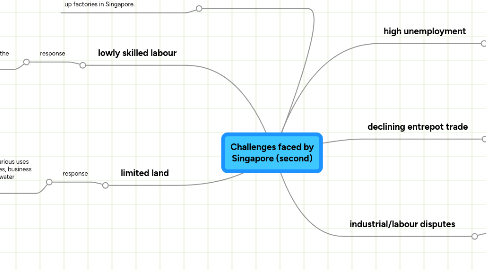
1. lowly skilled labour
1.1. response
1.1.1. technical education was introduced in schools in 1969. Both boys and girls were encouraged to take up technical education. EDB started a number of industrial training schemes to upgrade the skills of workers who were already in the workforce.
2. limited land
2.1. response
2.1.1. had to be carefully planned for various uses such as industries, housing estates, business districts, farming, reservoirs and water catchment areas
3. weak industrial base
3.1. It encourage foreign investors from Japan, Western Europe and America to set up factories in Singapore.
4. high unemployment
4.1. response
4.1.1. Singapore's solution was to set up labour-intensive manufacturing industries such as assembly plants that employed a large number of workers.
5. industrial/labour disputes
5.1. response
5.1.1. a new labour law was passed in 1968 to maintain industrial peace. It defined the rights of unions and management in matters such as recruitment, promotion and dismissal.
6. declining entrepot trade
6.1. response
6.1.1. Singapore's government built on their strategic geographical location and the fact that they established ship repair industries in the 1950s to further develop Singapore's habour into a world-class seaport to promote international trade.
